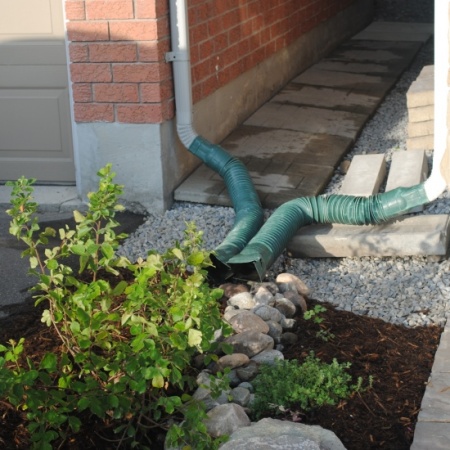Difference between revisions of "Rain gardens"
Jump to navigation
Jump to search
Jenny Hill (talk | contribs) |
Jenny Hill (talk | contribs) |
||
| Line 5: | Line 5: | ||
{{TOClimit|2}} | {{TOClimit|2}} | ||
===Overview=== | ===Overview=== | ||
| − | |||
<p>Rain gardens capture roof, lawn and driveway runoff from low to medium density residential lots. These can be simple gardens constructed by the homeowner as a retrofit, or they can be professionally designed into a residential development. | <p>Rain gardens capture roof, lawn and driveway runoff from low to medium density residential lots. These can be simple gardens constructed by the homeowner as a retrofit, or they can be professionally designed into a residential development. | ||
</p> | </p> | ||
| − | |||
{{TextBox|1=Rain gardens are ideal for: | {{TextBox|1=Rain gardens are ideal for: | ||
*Capturing the flow from disconnected downspouts | *Capturing the flow from disconnected downspouts | ||
*Community design/build projects for raising awareness about stormwater capture and functional landscapes}} | *Community design/build projects for raising awareness about stormwater capture and functional landscapes}} | ||
| − | |||
<p><strong>The fundamental components of a rain garden are:</strong> | <p><strong>The fundamental components of a rain garden are:</strong> | ||
*An amended soil mix | *An amended soil mix | ||
| Line 20: | Line 17: | ||
*An overflow channel to another are of garden | *An overflow channel to another are of garden | ||
</p> | </p> | ||
| − | |||
</div> | </div> | ||
<div class="col-md-4"> | <div class="col-md-4"> | ||
| − | |||
<panelSuccess> | <panelSuccess> | ||
<gallery mode="packed" widths=300px heights=300px> | <gallery mode="packed" widths=300px heights=300px> | ||
| Line 29: | Line 24: | ||
</gallery> | </gallery> | ||
</panelSuccess> | </panelSuccess> | ||
| − | |||
</div> | </div> | ||
<div class="col-md-12"> | <div class="col-md-12"> | ||
---- | ---- | ||
| − | |||
===Planning Considerations=== | ===Planning Considerations=== | ||
| − | |||
| − | |||
---- | ---- | ||
| − | |||
===Design=== | ===Design=== | ||
| − | |||
| − | |||
| − | |||
| − | |||
| − | |||
| − | |||
| − | |||
| − | |||
| − | |||
| − | |||
| − | |||
| − | |||
| − | |||
| − | |||
| − | |||
---- | ---- | ||
===Incentives and Credits=== | ===Incentives and Credits=== | ||
<h4>In Ontario</h4> | <h4>In Ontario</h4> | ||
| − | |||
| − | |||
---- | ---- | ||
| − | |||
===See Also=== | ===See Also=== | ||
<ul> | <ul> | ||
| Line 68: | Line 40: | ||
</ul> | </ul> | ||
---- | ---- | ||
| − | |||
===External Links=== | ===External Links=== | ||
<ul> | <ul> | ||
| Line 74: | Line 45: | ||
</ul> | </ul> | ||
---- | ---- | ||
| − | + | {{:Feedback}} | |
| − | + | [[category:infiltration]] | |
| − | |||
Revision as of 12:18, 13 July 2017
This article is about planted installations designed to capture surface runoff in an amended soil.
For more highly engineered systems, see Bioretention cells.
Overview[edit]
Rain gardens capture roof, lawn and driveway runoff from low to medium density residential lots. These can be simple gardens constructed by the homeowner as a retrofit, or they can be professionally designed into a residential development.
Rain gardens are ideal for:
- Capturing the flow from disconnected downspouts
- Community design/build projects for raising awareness about stormwater capture and functional landscapes
The fundamental components of a rain garden are:
- An amended soil mix
- Suitable planting
Additional components may include:
- A splash pad of rocks to prevent the downspout flow from eroding the soil
- An overflow channel to another are of garden
